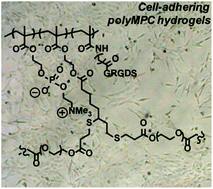Promoting cell adhesion on slippery phosphorylcholine hydrogel surfaces†
Abstract
The growing interest in regenerative medicine has created a need for superior polymer matrices that suit multiple physical, mechanical, and biological requirements. While the phospholipid bilayer of a cell membrane is considered optimal for interacting with biologics, polymeric materials composed of 2-methacryloyloxyethyl phosphorylcholine (MPC) offer a cell membrane-like synthetic alternative. In this work, thiol-containing phosphorylcholine polymers were synthesized by radical copolymerization of a lipoic acid-functionalized methacrylate with MPC. The canonical cell adhesion oligopeptide (GRGDS) was incorporated into the polymers by copolymerization of a GRGDS-containing methacrylamide prepared by solid phase peptide synthesis. The relative amounts of phosphorylcholine, lipoic acid and oligopeptide were controlled by the monomer feed ratios, and the polymers were characterized by NMR spectroscopy and aqueous gel permeation chromatography (GPC). These multifunctional polymers formed hydrogels rapidly (<10 minutes) by Michael addition when poly(ethylene glycol)diacrylate (PEGDA) was added at pH 9 – an initiator-free gelation performed in a completely aqueous environment. Two cell lines, live mouse skeletal muscle myoblasts (C2C12) and human ovarian cancer (SKOV3) cells, were observed to specifically attach, spread and proliferate only on hydrogels containing the GRGDS peptide sequence, with a notable dependence on peptide concentration. The remarkable hydrophilicity and biocompatibility attributed to polyMPC combined with the facile gelation conditions of these polymers affords a platform of new bio-cooperative materials suitable for cell studies.


 Please wait while we load your content...
Please wait while we load your content...